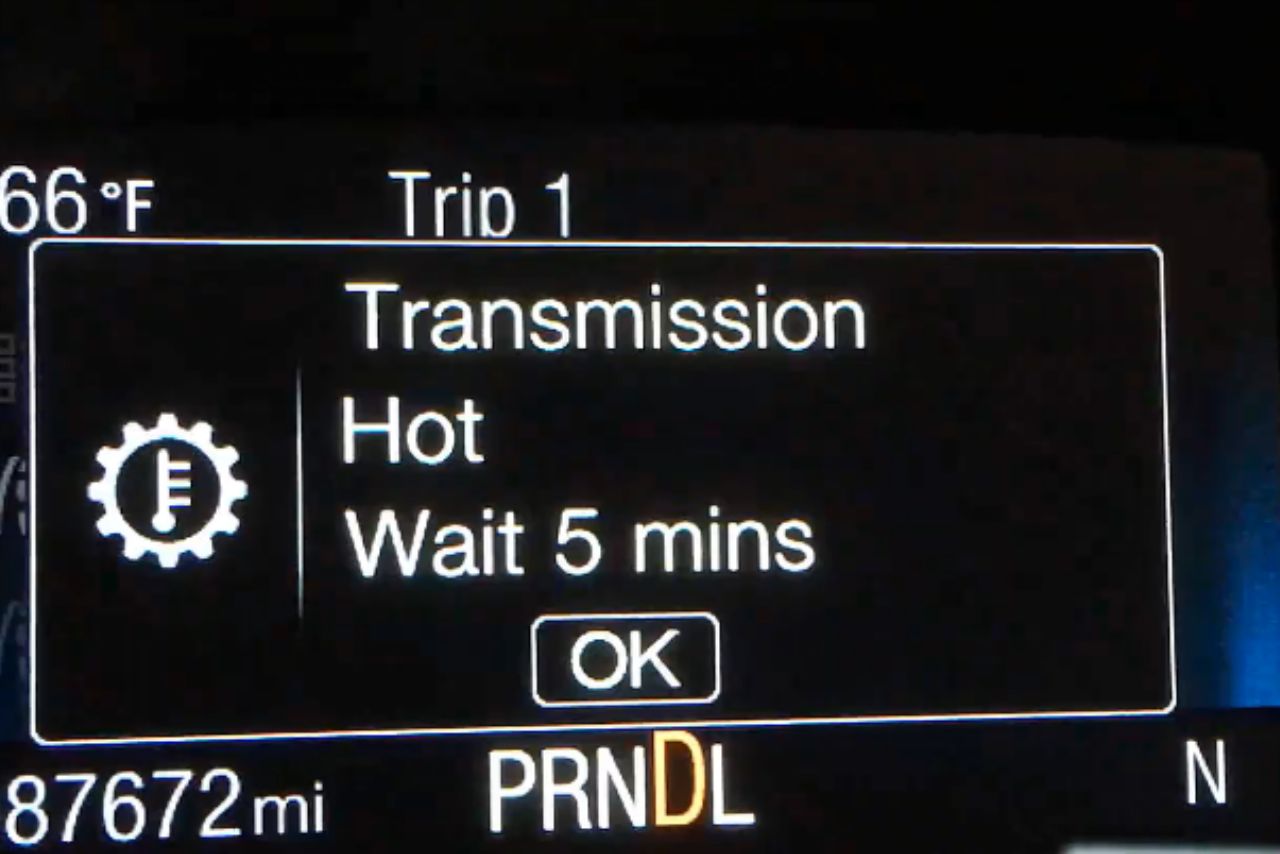If you’ve ever seen the message “transmission hot, wait 5 minutes” appear on your vehicle’s dashboard, it might have left you scratching your head.
This seemingly cryptic alert is actually a common warning in many modern cars when the transmission fluid temperature has reached a higher level than what’s considered safe for operation.
In layman’s terms, it means your car needs to take a breather and cool down its transmission system before any further driving can be done safely.
Understanding this signal can help prevent serious damage to your vehicle and save on potentially hefty repair bills.
So let’s dive into what causes this warning light to pop up, how seriously you should take it, and some tips to avoid overheating issues in the future.
Experiencing a “Transmission Hot, Wait 5 Minutes” message? It could be due to excessive clutch slippage. Avoid prolonged driving in this state, and when stopped, putting your foot on the brake effectively puts it in neutral. Excessive creeping, especially in slow traffic, can trigger this warning due to repeated clutch engagement. Waiting for sufficient traffic clearance before moving at higher speeds reduces the risk of overheating.
Table of Contents
Common Causes of Transmission Hot, Wait 5 Minutes:
In the world of cars, a hot transmission can spell trouble. So what causes this problem? Let’s dive into some common culprits:
Here are these points in more detail:
- Low Fluid Levels If your car’s transmission fluid level is too low, there isn’t enough to keep things cool and lubricated. It’s like running a marathon without water—things start to overheat quickly!
- Old or Poor Quality Fluid Just as with engine oil, transmission fluids degrade over time and lose their cooling properties which could result in an overheated system.
- Towing Heavy Loads Pulling heavy loads puts stress on your vehicle’s engine which increases heat production that may overwhelm the cooling capacity of the transmission system leading to potential damage.
A summary table for quick reference:
| Issues | Consequences |
|---|---|
| Low Fluid Levels | Insufficient coolant leads to rapid heating |
| Old/Poor Quality Fluid | Reduced cooling efficiency resulting in increased temperatures |
| Towing Heavy Loads | Excessive heat generation due high load on engine |
Remember: A well-maintained car minimizes chances for an overheated transmission!
Symptoms of a Hot Transmission:

When your transmission gets hot, it’s not just an inconvenience. It can lead to serious damage or even failure for your vehicle. Here are some common signs that your transmission might be overheating:
| Symptom | Cause |
|---|---|
| Burning Smell | Overheating parts start to burn |
| Delayed Shifting | Fluid responsible for shifting has lost its properties because of high temperature |
| Fluid Leaks | Seals and gaskets fail under high temperatures causing leaks |
| Warning Light on Dashboard | Sensors detect high temperature |
Remember these symptoms so you can identify them early and prevent costly repairs down the line!
Watch this video to understand more:
How to Check the Transmission Fluid Level?
Before we dive into the steps, remember: safety first! Ensure your vehicle is on a level surface and you’re wearing protective gear.
Follow these simple steps:
- Good fluid = Clear red
- Bad fluid = Brown/black and smells burnt
If low, add more; if burnt, take your car to a professional immediately!
Here’s what good vs bad looks like:
| Good Fluid | Bad Fluid |
|---|---|
| Clear Red | Brown/Black |
| Mild Smell | Burnt Smell |
Always refer back to this guide when checking transmission fluids!
Steps to Cool Down an Overheated Transmission:

Overheating is a common problem with car transmissions. Here’s what you can do when your vehicle says “transmission hot wait 5 minutes”.
Signs of Damage Caused by Overheating:
Your vehicle’s transmission might overheat, leading to substantial damage if not addressed promptly. Here are some signs indicating possible harm from overheating:
In addition to these symptoms, there exist certain damages often associated with an overheated transmission:
| Damage | Description |
|---|---|
| Clutch Warping | The clutch plates may warp due to excessive heat, impeding proper gear shifts. |
| Seal Failure | High temperatures can lead seals and gaskets within the system to fail and leak fluid. |
| Complete Breakdown | In severe cases, high temperatures can cause complete failure of the entire system requiring replacement. |
Remember:
- Regularly check for these signs.
- Schedule periodic maintenance.
- Seek professional help if symptoms persist.
The key is prevention rather than cure!
Importance of Regular Maintenance for Your Transmission:
Regular maintenance is key to keep your vehicle’s transmission in top condition. Here’s why it matters:
Consider these critical points during regular maintenance:
Remember that neglecting regular maintenance will result in more frequent trips to a mechanic and high repair costs!
Tips to Prevent Transmission Overheating:
Here are some handy tips to keep your transmission cool and stop the dreaded “transmission hot wait 5 minutes” message:
When it comes to preventive maintenance, consider this simple table:
| Maintenance Task | Frequency |
|---|---|
| Check fluid levels | Every month |
| Change transmission fluid | Every 30,000 miles |
And don’t forget these three key points:
- Avoid aggressive driving: Rapid acceleration generates heat.
- Don’t tow heavy loads in overdrive mode: This puts strain on the transmission.
- Use brakes instead of downshifting when slowing down: Downshifting creates extra heat too.
By following these guidelines, you’ll reduce your chances of overheating and prolong the life of your vehicle’s transmission!
When to Seek Professional Help for an Overheated Transmission?
If your transmission warning light shows “transmission hot, wait 5 minutes”, it’s time to get serious. This is not a typical DIY fix and needs professional attention. Here are the key signs that you need expert help:
The urgency of Getting Professional Help:
Here’s why waiting isn’t advisable when facing these issues:
- Prevents Further Damage: Quick action can prevent further damage saving you thousands in repair costs.
- Safety Concerns: An overheating transmission could lead to more severe problems like total vehicle failure on roadways, posing safety risks.
| Issue | Urgency |
|---|---|
| Persistent Warning Light | High |
| Burning Smell | Very High |
Don’t delay in seeking professional help if any of these signs persist. Your vehicle’s health and your safety depend on it!
Understanding the Cooling System in Your Vehicle:
Every vehicle comes equipped with a cooling system, primarily designed to prevent overheating. When your transmission gets too hot and displays “transmission hot – wait 5 minutes,” it’s time for some cooling down!
Key Components of the Cooling System:
Here’s how this system works:
- Thermostat detects high temperature
- Opens up allowing coolant from radiator into engine block
- Heat from engine warms up coolant
- Warm coolant cycles back into the radiator
- Cooled again by passing air (thanks to fans or vehicle motion)
- Continues this cycle maintaining optimal operating temperatures.
| Component | Role |
|---|---|
| Radiator | Dissipates heat |
| Water Pump | Circulates Coolant |
| Thermostat | Regulates Coolant Flow |
| Cooling Fans | Enhances Air Circulation |
Remember, if you see that “Transmission Hot” warning, take it seriously! It could mean your cooling system isn’t working properly – let your car rest for at least five minutes before proceeding cautiously!
Proper Driving Habits to Avoid Excessive Heat Build-Up:
When it comes to driving, certain habits can help you avoid excessive heat build-up in your transmission. Here are some tips:
Here’s a simple table that shows how often you should replace your transmission fluid:
| Mileage | Frequency |
|---|---|
| 30,000 | Every Year |
| 60,000 | Every Two Years |
| 90,000 | Every Three Years |
- Don’t Idle for Long Periods: Idling for long periods can cause your car engine and subsequently the transmission to overheat.
It’s important not only practice these habits but also be aware of any changes in your vehicle performance as they could indicate issues with the temperature regulation system. For instance:
- A sudden drop in fuel efficiency.
- The smell of burning when driving or parked.
- Unusual noises from under the hood.
Remember: Prevention is better than cure! By adopting these practices, you reduce chances of overheating and prolong the life of your car’s transmission system.
Conclusion and final thoughts
In essence, the “transmission hot wait 5 minutes” message is your car’s way of communicating that it needs a moment to cool down. This safeguard prevents damage from overheating and ensures longevity for your transmission system.
Be sure to take this warning seriously; doing so will help you avoid costly repairs and ensure optimal vehicular performance.
Remember, consistent maintenance is key when dealing with any vehicle-related issue. Regular check-ups allow for early detection of problems, preventing small issues from escalating into bigger ones.
So next time you see the “transmission hot wait 5 minutes” alert – don’t panic! Let your vehicle rest, consult a professional if needed, and keep up with regular servicing for smooth rides ahead.
Latest Posts:
- Can WD-40 Remove Scratches on Cars? (Hint: Yes, but…)
- Can You Use a Drill to Polish Your Car? (We Tried it Out!)
- Should You Cover Car Scratches With Stickers? (REVEALED!)
- Buick Service Stabilitrak: (Causes & 100% Guaranteed Fix!)
- Common Holden Trax Problems (Causes & 100% Proven Fixes!)
- Jeep Commander Transmission Over Temp: (Guaranteed Fix!)












Leave a Reply